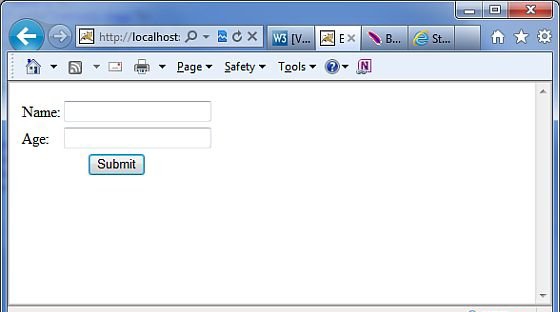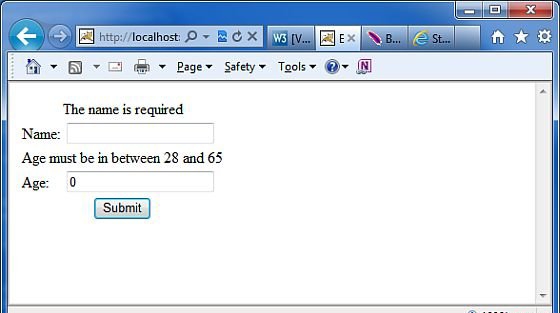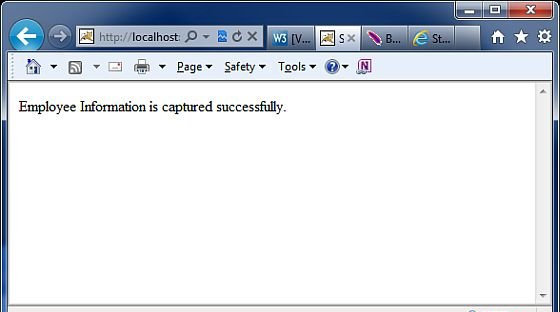要开始在你的项目中使用注释,确保WebContent/WEB-INF/lib文件夹中的jar文件包括以下:
- struts2-convention-plugin-x.y.z.jar
- asm-x.y.jar
- antlr-x.y.z.jar
- commons-fileupload-x.y.z.jar
- commons-io-x.y.z.jar
- commons-lang-x.y.jar
- commons-logging-x.y.z.jar
- commons-logging-api-x.y.jar
- freemarker-x.y.z.jar
- javassist-.xy.z.GA
- ognl-x.y.z.jar
- struts2-core-x.y.z.jar
- xwork-core.x.y.z.jar
现在,让我们看看你如何能做到配置在struts.xml文件,取而代之的是注解。
Struts2注释的概念的解释,我们需要重新考虑我们的验证为例说明在 Struts2的验证 一章中。
在这里,我们将采取一个例子,雇员Employee 将被捕获的姓名和年龄使用一个简单的页面,我们将会把两个验证,以确保使用总是进入一个名字和年龄应该是在28和65之间。所以,让我们先从主JSP页面的例子。
创建主页:
让我们写主JSP页面文件index.jsp,这将被用来收集上述员工的相关信息。
|
1
2
3
4
5
6
7
8
9
10
11
12
13
14
15
16
17
18
19
20
|
<%@ page language="java" contentType="text/html; charset=ISO-8859-1" pageEncoding="ISO-8859-1"%><%@ taglib prefix="s" uri="/struts-tags"%><!DOCTYPE html PUBLIC "-//W3C//DTD HTML 4.01 Transitional//EN""http://www.w3.org/TR/html4/loose.dtd"><html><head><title>Employee Form</title></head><body> <s:form action="empinfo" method="post"> <s:textfield name="name" label="Name" size="20" /> <s:textfield name="age" label="Age" size="20" /> <s:submit name="submit" label="Submit" align="center" /> </s:form></body></html> |
在index.jsp使用Struts的标签,我们还没有覆盖,但我们将研究这些标签相关的章节。但现在,假设s:textfield 标签打印一个输入字段 s:submit 打印一个提交按钮。我们已经使用label属性标签,每个标签每个标签创建。
创建视图:
我们将使用JSP文件的success.jsp将调用的情况下定义的动作返回SUCCESS。
|
1
2
3
4
5
6
7
8
9
10
11
12
13
|
<%@ page language="java" contentType="text/html; charset=ISO-8859-1" pageEncoding="ISO-8859-1"%><%@ taglib prefix="s" uri="/struts-tags"%><!DOCTYPE html PUBLIC "-//W3C//DTD HTML 4.01 Transitional//EN""http://www.w3.org/TR/html4/loose.dtd"><html><head><title>Success</title></head><body> Employee Information is captured successfully.</body></html> |
创建动作:
这是将用于注释的地方。让我们重新定义行动Employee类的注释,然后添加一个方法称为validate() ,如下所示在Employee.java文件。请确保操作类扩展ActionSupport类,否则validate方法将不会被执行。
package com.yiibai.struts2;
|
1
2
3
4
5
6
7
8
9
10
11
12
13
14
15
16
17
18
19
20
21
22
23
24
25
26
27
28
29
30
31
32
33
34
35
36
37
|
import com.opensymphony.xwork2.ActionSupport;import org.apache.struts2.convention.annotation.Action;import org.apache.struts2.convention.annotation.Result;import org.apache.struts2.convention.annotation.Results;import com.opensymphony.xwork2.validator.annotations.*;@Results({ @Result(name="success", location="/success.jsp"), @Result(name="input", location="/index.jsp")})public class Employee extends ActionSupport{ private String name; private int age; @Action(value="/empinfo") public String execute() { return SUCCESS; } @RequiredFieldValidator( message = "The name is required" ) public String getName() { return name; } public void setName(String name) { this.name = name; } @IntRangeFieldValidator(message = "Age must be in between 28 and 65", min = "29", max = "65") public int getAge() { return age; } public void setAge(int age) { this.age = age; }} |
在这个例子中,我们已经使用了一些注解。让我逐个说明:
首先,我们已经Result注解。结果注解的结果是一个集合。结果注解下,我们有两个结果注释。结果注释的名称对应的执行方法的结果。它们还含有一个视图应担任相应的execute() 返回值的位置。
下一个注解是行动注解。这是用来修饰 execute()方法。操作方法也需要一个值,该URL上调用操作。
最后,使用两个验证的注解。已经配置了所需的字段验证的年龄字段"name“字段和整数范围验证。也指定了自定义验证消息。
配置文件:
我们不需要struts.xml 配置文件,让我们删除该文件,并让我们检查web.xml文件中的内容:
|
1
2
3
4
5
6
7
8
9
10
11
12
13
14
15
16
17
18
19
20
21
22
23
24
25
26
27
28
29
|
<?xml version="1.0" encoding="UTF-8"?><web-app xmlns:xsi="http://www.w3.org/2001/XMLSchema-instance" xmlns="http://java.sun.com/xml/ns/javaee" xmlns:web="http://java.sun.com/xml/ns/javaee/web-app_2_5.xsd" xsi:schemaLocation="http://java.sun.com/xml/ns/javaee http://java.sun.com/xml/ns/javaee/web-app_3_0.xsd" id="WebApp_ID" version="3.0"> <display-name>Struts 2</display-name> <welcome-file-list> <welcome-file>index.jsp</welcome-file> </welcome-file-list> <filter> <filter-name>struts2</filter-name> <filter-class> org.apache.struts2.dispatcher.FilterDispatcher </filter-class> <init-param> <param-name>struts.devMode</param-name> <param-value>true</param-value> </init-param> </filter> <filter-mapping> <filter-name>struts2</filter-name> <url-pattern>/*</url-pattern> </filter-mapping></web-app> |
现在,右键点击项目名称,并单击 Export > WAR File创建一个WAR文件。然后部署此WAR在Tomcat的webapps目录下。最后,启动Tomcat服务器和尝试访问URL http://localhost:8080/HelloWorldStruts2/index.jsp。这会给出以下画面:

现在不输入任何所需信息,只需点击“Submit ”按钮。将看到以下结果:

输入所需的信息,但输入了错误的“From ”字段,让我们说“test”和年龄为30名,最后点击“Submit ”按钮。将看到以下结果:

Struts 2的注释类型
Struts 2 应用程序可以使用Java5注释作为替代XML和Java属性配置。可以检查最重要的注解涉及不同类别的列表:
Struts 2 应用程序可以使用Java5注释作为替代XML和Java属性配置。这里是清单的不同的类别有关的最重要的注解:
命名空间注释(动作注释):
@ Namespace注释允许在Action类中,而不是基于零配置的约定动作的命名空间的定义。
|
1
2
3
4
|
@Namespace("/content")public class Employee extends ActionSupport{ ...} |
结果注释 - (动作译注):
@ Result注解允许在Action类中,而不是一个XML文件中定义的动作结果。
|
1
2
3
4
|
@Result(name="success", value="/success.jsp")public class Employee extends ActionSupport{ ...} |
结果注释 - (动作译注):
@ Results注解定义了一套动作的结果。
|
1
2
3
4
5
6
7
|
@Results({ @Result(name="success", value="/success.jsp"), @Result(name="error", value="/error.jsp")})public class Employee extends ActionSupport{ ...} |
注释后(拦截注释):
@After注解标志着一个需要调用后的主要操作方法和执行结果的操作方法。返回值将被忽略。
|
1
2
3
4
5
6
7
8
9
10
|
public class Employee extends ActionSupport{ @After public void isValid() throws ValidationException { // validate model object, throw exception if failed } public String execute() { // perform secure action return SUCCESS; }} |
注释之前(拦截注释):
@ Before注释标记需要一个操作方法的主要操作方法之前被调用执行结果。返回值将被忽略。
|
1
2
3
4
5
6
7
8
9
10
|
public class Employee extends ActionSupport{ @Before public void isAuthorized() throws AuthenticationException { // authorize request, throw exception if failed } public String execute() { // perform secure action return SUCCESS; }} |
BeforeResult注释 - (拦截注释):
@ BeforeResult注解标志着一个结果之前需要执行的操作方法。返回值将被忽略。
|
1
2
3
4
5
6
7
8
9
10
11
|
public class Employee extends ActionSupport{ @BeforeResult public void isValid() throws ValidationException { // validate model object, throw exception if failed } public String execute() { // perform action return SUCCESS; }} |
ConversionErrorFieldValidator注释 - (验证译注):
此验证注解如果有任何转换错误进行了实地检查,并适用于他们,如果他们存在。
|
1
2
3
4
5
6
7
|
public class Employee extends ActionSupport{ @ConversionErrorFieldValidator(message = "Default message", key = "i18n.key", shortCircuit = true) public String getName() { return name; }} |
DateRangeFieldValidator注释 - (验证译注):
这验证注解检查日期字段的值在指定范围内。
|
1
2
3
4
5
6
7
8
|
public class Employee extends ActionSupport{ @DateRangeFieldValidator(message = "Default message", key = "i18n.key", shortCircuit = true, min = "2005/01/01", max = "2005/12/31") public String getDOB() { return dob; }} |
DoubleRangeFieldValidator注释 - (验证译注):
此验证注解检查双字段有一个值,该值在指定范围内。如果既不最小或最大,什么都不会做的。
|
1
2
3
4
5
6
7
8
9
|
public class Employee extends ActionSupport{ @DoubleRangeFieldValidator(message = "Default message", key = "i18n.key", shortCircuit = true, minInclusive = "0.123", maxInclusive = "99.987") public String getIncome() { return income; }} |
EmailValidator注释 - (验证译注):
这验证注解检查一个字段是一个有效的E-mail地址,如果它包含一个非空的字符串。
|
1
2
3
4
5
6
7
8
|
public class Employee extends ActionSupport{ @EmailValidator(message = "Default message", key = "i18n.key", shortCircuit = true) public String getEmail() { return email; }} |
ExpressionValidator注释 - (验证译注):
这种非字段级验证验证所提供的正则表达式。
@ExpressionValidator(message = "Default message", key = "i18n.key",
shortCircuit = true, expression = "an OGNL expression" )
IntRangeFieldValidator注释 - (验证译注):
这验证注解检查一个数字字段的值在指定的范围内。如果既不最小或最大,什么都不会做的。
|
1
2
3
4
5
6
7
8
9
|
public class Employee extends ActionSupport{ @IntRangeFieldValidator(message = "Default message", key = "i18n.key", shortCircuit = true, min = "0", max = "42") public String getAge() { return age; }} |
RegexFieldValidator 注释 - (验证译注):
这个注解验证一个字符串字段,使用正则表达式。
@RegexFieldValidator( key = "regex.field", expression = "yourregexp")
RequiredFieldValidator 注释 - (验证译注):
这验证注解检查一个字段不为空。标注必须被应用在方法层面。
|
1
2
3
4
5
6
7
8
|
public class Employee extends ActionSupport{ @RequiredFieldValidator(message = "Default message", key = "i18n.key", shortCircuit = true) public String getAge() { return age; }} |
RequiredStringValidator注释 - (验证译注):
这验证注解检查一个字符串字段不为空(即非空,长度> 0)。
|
1
2
3
4
5
6
7
8
|
public class Employee extends ActionSupport{ @RequiredStringValidator(message = "Default message", key = "i18n.key", shortCircuit = true, trim = true) public String getName() { return name; }} |
StringLengthFieldValidator注释 - (验证译注):
这个验证检查字符串字段是合适的长度。假定该字段是一个字符串。如果设置既不是minLength 也不是最大长度,什么都不会做。
|
1
2
3
4
5
6
7
8
9
|
public class Employee extends ActionSupport{ @StringLengthFieldValidator(message = "Default message", key = "i18n.key", shortCircuit = true, trim = true, minLength = "5", maxLength = "12") public String getName() { return name; }} |
UrlValidator注释 - (验证译注):
这个验证检查一个字段是一个有效的URL。
|
1
2
3
4
5
6
7
8
|
public class Employee extends ActionSupport{ @UrlValidator(message = "Default message", key = "i18n.key", shortCircuit = true) public String getURL() { return url; }} |
验证注释 - (验证译注):
如果想使用多个相同类型的注释,这些注释必须嵌套在@Validations() 注释。
|
1
2
3
4
5
6
7
8
9
10
11
12
13
14
15
16
|
public class Employee extends ActionSupport{ @Validations( requiredFields = {@RequiredFieldValidator(type = ValidatorType.SIMPLE, fieldName = "customfield", message = "You must enter a value for field.")}, requiredStrings = {@RequiredStringValidator(type = ValidatorType.SIMPLE, fieldName = "stringisrequired", message = "You must enter a value for string.")} ) public String getName() { return name; }} |
CustomValidator注释 - (验证译注):
这个注解可以用于自定义验证。使用ValidationParameter的注释,以提供额外的 params.
|
1
|
@CustomValidator(type ="customValidatorName", fieldName = "myField") |
转换注释 - (类型转换注释):
这是一个标记注释类型转换类型级别。转换注释必须应用在类型级别。
|
1
2
3
|
@Conversion() public class ConversionAction implements Action {} |
CreateIfNull注释 - (类型转换注释):
这个注解设置类型转换CreateIfNull。必须应用在域或方法级CreateIfNull注解。
|
1
2
|
@CreateIfNull( value = true )private List<User> users; |
元素注释 - (类型转换注释):
这个注解设置元素进行类型转换。必须应用在字段域或方法级元素的注解。
|
1
2
|
@Element( value = com.acme.User )private List<User> userList; |
关键注释 - (类型转换注释):
这个注解设置进行类型转换的关键。必须应用在域或方法级的关键注解。
|
1
2
|
@Key( value = java.lang.Long.class )private Map<Long, User> userMap; |
KeyProperty注释 - (类型转换注释):
这个注解设置类型转换KeyProperty。必须应用在域或方法级KeyProperty注解。
|
1
2
|
@KeyProperty( value = "userName" )protected List<User> users = null; |
TypeConversion注释 - (类型转换注释):
这个注解的注解是用于类和应用程序的转换规则。注解可以应用于TypeConversion在属性和方法的级别。
|
1
2
3
4
5
|
@TypeConversion(rule = ConversionRule.COLLECTION, converter = "java.util.String")public void setUsers( List users ) { this.users = users;} |











